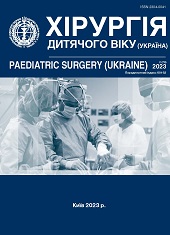Simultaneous treatment for anal fissure and hemorrhoids
DOI:
https://doi.org/10.15574/PS.2023.79.66Keywords:
hemorrhoids, anal fissure, laser Doppler flowmetry, transanal hemorrhoidal dearterialization (THD), fissure excisionAbstract
When using surgical approach to treatment for combined anal fissure and hemorrhoids doctor always faces the question of whether to divide the procedure into two sequential stages or to perform a simultaneous surgical intervention, and in which cases one or the other should be done.
Purpose - to improve the results of treatment for patients with anal fissure in combination with chronic hemorrhoids by combining fissurectomy with transanal hemorrhoidal dearterialization (THD).
Materials and methods. 177 patients with combination of anal fissure and hemorrhoids were studied. The Group I (GI) - fissure excision and hemorrhoidectomy, 60 patients. The Group II (GII) - anal fissure excision without surgery for hemorrhoids, 60 patients. The Group III (GIII) - proposed method used, 57 patients. Laser Doppler flowmetry was performed to assess blood flow intensity in fissure area. The assessment of treatment outcomes in patients was based on the following criteria: pain intensity, urinary retention in early postoperative period, postoperative wound suppuration, disease recurrence, iatrogenic incontinence, duration of postoperative hospital stay. Qualitative parameters are presented as the absolute number of cases (n) and their percentage (%). Comparison of these parameters between groups was performed using the Pearson’s χ2 test and the Fisher’s exact test. Statistical analysis was conducted by STATA 12.1 statistical package.
Results. Pain intensity: GI - 8±1, GII - 6±2, GIII - 4±1. Urinary retention: GI - 19 (31.6%), GII - 8 (13%), GIII - 6 (10.5%). Wound suppuration: GI - 5 (8.3%), GII - 1 (1.7%), GIII - 1 (1.7%). Hospital stay (days): GI - 6±1.2, GII - 4±1.3, GIII - 3±1.1. Fissure recurrences: GI - 5 (8.3%), GII - 2 (3.3%), GIII - 1 (1.7%). Hemorrhoid recurrence: GI - 6 (10%), GIII - 2 (3.5%). Iatrogenic incontinence: GI - 4 (6.7%), GII - 1 (1.7%), GIII - 0. Significant decrease in relative risk of complications (by 88%) in GIII compared with GI - OR=0.12 (0.04-0.29), p=0.0001, and a tendency to reduction of complication risk by 15% compared with GII - OR=0.85 (0.29-2.4), p=0.734 was observed. Blood flow intensity (flowmetry results) in GII and GIII was comparable.
Conclusions. Simultaneous anal fissure excision and THD can improve treatment outcomes. This method does not impair blood flow in the area of anal fissure. Proposed method is both radical and minimally invasive.
The research was carried out in accordance with the principles of the Helsinki Declaration. The study protocol was approved by the Local Ethics Committee of all participating institutions. The informed consent of the patient was obtained for conducting the studies.
No conflict of interests was declared by the authors.
References
Alvarez-Downing MM, da Silva G. (2022, Jan 1). 'Bumps down under' hemorrhoids, skin tags and all things perianal. Current Opinion in Gastroenterology. 38 (1): 61-66. https://doi.org/10.1097/MOG.0000000000000795; PMid:34636364
Brown SR. (2017). Haemorrhoids: an update on management. Therapeutic Advances in Chronic Disease. 8 (10): 141-147. https://doi.org/10.1177/2040622317713957; PMid:28989595 PMCid:PMC5624348
Giordano P, Schembari E. (2021). Transanal Hemorrhoidal Dearterialization (THD) Anolift-Prospective Assessment of Safety and Efficacy. Front. Surg. 8: 704164. https://doi.org/10.3389/fsurg.2021.704164; PMid:34631778 PMCid:PMC8493063
Guttenplan M. (2017). The Evaluation and Office Management of Hemorrhoids for the Gastroenterologist. Current Gastroenterology Reports. 19: 7. https://doi.org/10.1007/s11894-017-0574-9; PMid:28567655
Hsu TC, MacKeigan JM. (1984). Surgical treatment of chronic anal fissure: a retrospective study of 1753 cases. Dis Colon Rectum. 27: 475-478. https://doi.org/10.1007/BF02555546; PMid:6745021
Kondratenko PH, Huberhryts NB, Эlyn FE, Smyrnov NL. (2006). Klynycheskaia koloproktolohyia. Rukovodstvo dlia vrachei. Kh.: Fakt.
Rayimbekov OR. (2015). Optymyzatsyia lechenyia analnoi treshchynы v sochetanyy s khronycheskym hemorroem. Molodoi ucheniy. 21 (101): 303-305. https://doi.org/10.1055/s-0041-106272
Sajad AS. (2021). Anal Fissure - an extensive update. Pol Przegl Chir. 93 (4): 46-56. https://doi.org/10.5604/01.3001.0014.4876; PMid:35384864
Schouten WR, Briel JW, Auwerda JJ, De Graaf EJ. (1996). Ischaemic nature of anal fissure. Br J Surg. 83: 63-65. https://doi.org/10.1002/bjs.1800830120; PMid:8653368
Stewart DB, Gaertner W, Glasgow S, Migaly J, Feingold D, Steele SR. (2017). Clinical Practice Guideline for the Management of Anal Fissures. Diseases of the Colon & Rectum. 60 (1): 7-14. https://doi.org/10.1097/DCR.0000000000000735; PMid:27926552
Trenti L, Biondo S, Galvez A, Bravo A, Cabrera J, Kreisler E. (2017). Distal Doppler-guided transanal hemorrhoidal dearterialization with mucopexy versus conventional hemorrhoidectomy for grade III and IV hemorrhoids: postoperative morbidity and long-term outcomes. Techniques in Coloproctology. 21 (5): 337-344. https://doi.org/10.1007/s10151-017-1620-1; PMid:28451767
Trilling B, Pflieger H, Faucheron JL. (2017). Decreased blood flow to the posterior anal canal shown during Doppler-guided hemorrhoidal artery ligation explains anodermal ischemia in anal fissure. Techniques in Coloproctology. 21 (5): 411-412. https://doi.org/10.1007/s10151-017-1636-6; PMid:28528352
Villanueva Herrero JA, Henning W, Sharma N, Deppen JG. (2021). Internal Anal Sphincterotomy. StatPearls. Treasure Island (FL): StatPearls Publishing.
Downloads
Published
Issue
Section
License
Copyright (c) 2023 Paediatric Surgery (Ukraine)

This work is licensed under a Creative Commons Attribution-NonCommercial 4.0 International License.
The policy of the Journal “PAEDIATRIC SURGERY. UKRAINE” is compatible with the vast majority of funders' of open access and self-archiving policies. The journal provides immediate open access route being convinced that everyone – not only scientists - can benefit from research results, and publishes articles exclusively under open access distribution, with a Creative Commons Attribution-Noncommercial 4.0 international license(СС BY-NC).
Authors transfer the copyright to the Journal “PAEDIATRIC SURGERY.UKRAINE” when the manuscript is accepted for publication. Authors declare that this manuscript has not been published nor is under simultaneous consideration for publication elsewhere. After publication, the articles become freely available on-line to the public.
Readers have the right to use, distribute, and reproduce articles in any medium, provided the articles and the journal are properly cited.
The use of published materials for commercial purposes is strongly prohibited.

